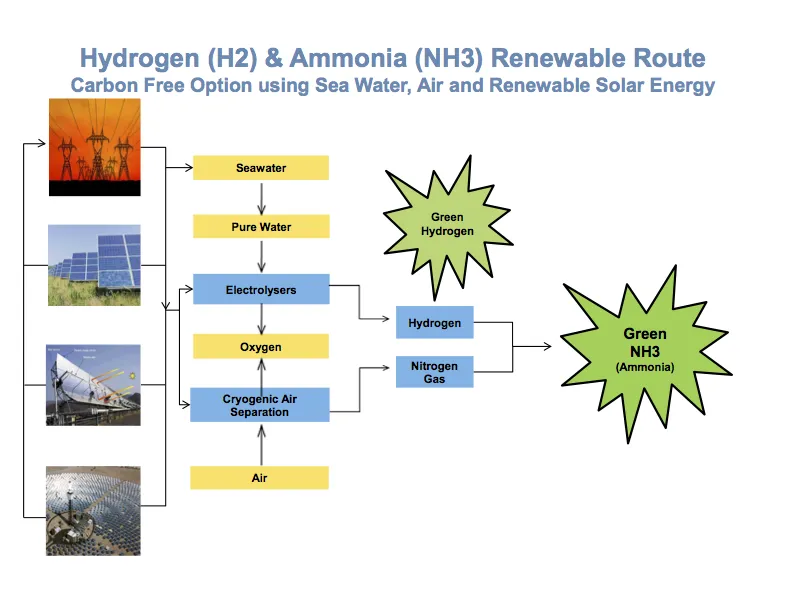Yara: solar ammonia pilot plant, for start-up in 2019
By Trevor Brown on September 22, 2017
Yara, the world’s biggest producer of ammonia, has announced that it intends to build a demonstration plant to produce ammonia using solar power, near its existing world-scale plant in the Pilbara, in Western Australia.
It expects to complete the feasibility study this year. Next year, in 2018, Yara hopes to finish the engineering design and begin construction so that it can complete the project and begin production of carbon-free ammonia in 2019.
The project has been in quiet development for some time but Chris Rijksen, General Manager of Yara Pilbara Fertilisers, made the announcement during his speech at a regional economic development conference for The New Pilbara in August, 2017.
Renewable ammonia … it is based on electrolyzers, also fully integrating all the initiatives that are going on in solar power and water treatment [desalination] in the region.
Here we are in the process of finishing the feasibility study. That feasibility study should be finalized by the end of this year, so that also during 2018 the detailed engineering and construction could take place. We also believe that in 2019 this first demo project could start production.
Chris Rijksen, Yara: Sponsor Address at The New Pilbara conference, 08/29/2017
If hydrocarbon feedstocks, like natural gas, can be replaced with renewable power, it will be a huge step forward for global sustainability. Today, ammonia production alone causes more than 1% of global carbon emissions, but there is reason to believe that renewable ammonia production could be cost-competitive already in certain locations – like in the Australian desert.
Yara isn’t the first to try this: the Raphael Schmuecker Memorial Solar-Hydrogen System, at Pinehurst Farm in Iowa, has been working on solar ammonia for a few years, with the aim of using it as both fertilizer for its corn fields and fuel for its tractor (that project, which is still in development, will be the subject of a presentation at the AIChE Annual Meeting in Minneapolis in November).
Yara is, however, by far the biggest company to build a solar ammonia plant, even if that means starting small.
This will be a demo project – it will be very small. Let there be no misunderstanding: this first step is really to get experience with the process, to see how it integrates into our production facility, so that we can scale up after that. And we’re quite ambitious because we believe that the future will show that the cost of solar power will start to come down and that it will really start to compete with the conventional technologies.
Chris Rijksen, Yara: Sponsor Address at The New Pilbara conference, 08/29/2017

Rijksen illustrated his talk with a process flow diagram to outline the “Renewable Route” for ammonia synthesis: the “Carbon Free Option using Sea Water, Air and Renewable Solar Energy.”
The small size of this demonstration plant is no indication of the market potential for solar ammonia production in Australia. Australia’s future clean-industry expansion is an idea I’ve covered before, with global corporations like Siemens working to make it a reality. If Yara’s demonstration system shows that larger-scale production could be competitive, there are two major steps in the ramp-up and build-out of this industry expansion.
First: scale up solar-ammonia production to the capacity of the existing Pilbara plant, replacing its huge natural gas purchases and carbon dioxide emissions with renewable power purchasing and no emissions.
Second: why stop at replacing one fossil-fueled plant – indeed, why stop at the ~200 million ton-per-year fertilizer market, when you could expand exponentially and start to export solar-ammonia into the billions of tons-per-year fuel market?
So what is the potential that we see? We believe that it could grow to a full replacement of our current natural gas consumption by producing hydrogen with a solar field … It could get to the level where it replaces our full production, but it could go even a step further.
In the long-term future you could think about making it so big that it could be a multiple of the current ammonia production of 800,000 tonnes per year. And then you could think about integration of ammonia into the world market, but also in the world market of renewable fuel production.
And it’s just an interesting statistic: currently we produce 180 million tons of ammonia worldwide – not only Yara, all the production facilities. If we would be able to take 1.5% of the fuel production in the world, that would double the amount of ammonia produced worldwide.
There is a tremendous potential to produce more renewable ammonia which could replace conventional fuel production in the future.
Chris Rijksen, Yara: Sponsor Address at The New Pilbara conference, 08/29/2017
You can also read the full article at AmmoniaIndustry.com.